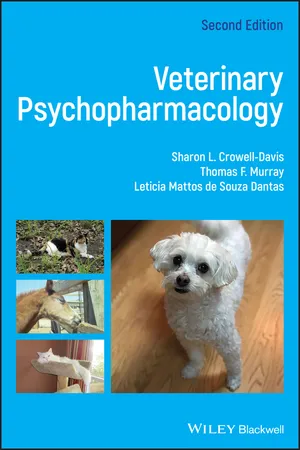
Veterinary Psychopharmacology
- English
- ePUB (mobile friendly)
- Available on iOS & Android
Veterinary Psychopharmacology
About This Book
Offers an updated second edition of the comprehensive reference on the use of drugs for veterinary mental health care and behavior modification
This fully revised Second Edition of Veterinary Psychopharmacology offers an authoritative reference to the drugs prescribed to treat psychiatric, psychological, and behavioral disorders in pets. Designed to be an accessible resource, the text is divided into sections on psychopharmacologic principles and clinical psychopharmacology. Comprehensive in scope, the book contains detailed information on pharmacologic intervention for pet mental health and behavior issues, offers thorough explanations of options, and explores why a particular drug should be prescribed and why it works.
Updated to include the recent advances in psychopharmacology for pets, the Second Edition includes new chapters that cover the principles of psychopharmacology, miscellaneous serotonergic agents, anticonvulsants and mood stabilizers, sympatholytic agents, and NMDA antagonists. In addition, the text explains the drug options, including all the information necessary to correct dysfunctions in the brain's chemistry through pharmacologic treatment. This important resource:
- Presents an updated and comprehensive resource for pharmacologic treatments for pet, equine, and zoo animal psychiatric disorders and behavior problems
- Contains in-depth information on drugs that promote neurochemical changes that will alter the mood, emotional state, reactivity, and behavior of the patient, including prescribing options and mechanisms of action
- Includes new chapters on the principles of psychopharmacology, miscellaneous serotonergic agents, mood stabilizers, sympatholytic agents, and NMDA antagonists
Written for veterinarians, veterinary behaviorists, and veterinary students, the updated second edition of Veterinary Psychopharmacology is a complete source for current knowledge on pharmacologic behavior modification. "Overall, this book packs a substantial amount of useful data into approximately 300 pages. The scope of the book is comprehensive and may include more in-depth information than casual prescribers seek, but it will be a good resource for the practitioners who are interested in immersing themselves into veterinary psychopharmacology." - JAVMA Vol 255 No. 6
Frequently asked questions
Information
Part I
Principles of Veterinary Psychopharmacology
1
General Principles of Psychopharmacology
Drug Action

Dose Dependence of Drug Interaction with Receptors

Table of contents
- Cover
- Table of Contents
- Contributors
- Preface
- Acknowledgments
- Part I: Principles of Veterinary Psychopharmacology
- Part II: Practice of Veterinary Psychopharmacology
- Index
- End User License Agreement